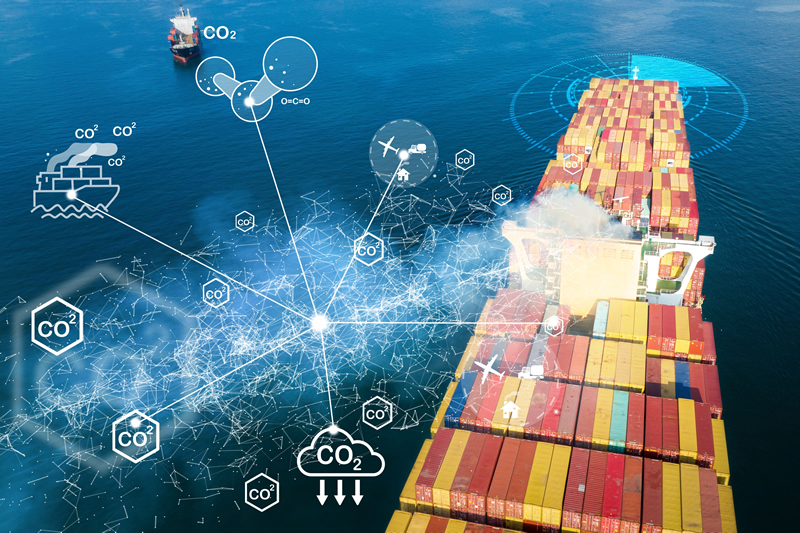Shipping Emissions In 2024 Return To 2008 Levels
23
Rising GHG emissions and slowing carbon intensity reductions in shipping. A new report from UCL and UMAS reveals increasing greenhouse gas (GHG) emissions and slowing reductions in carbon intensity in international shipping between 2018 and 2022. Building on the IMO’s Third and Fourth GHG Studies, to which both organisations contributed, the report provides critical insights into the sector’s response to global events and policy developments.

It examines the factors influencing emissions trends in key segments, including container ships, oil tankers, bulk carriers, and cruise ships, which collectively account for approximately 70% of the sector’s emissions. While efficiency improvements are observed in certain segments, the persistent growth in transport work necessitates more decisive action to meet the IMO’s Revised GHG Strategy targets adopted last year.
The Impact Of The Covid-19 Pandemic
The Covid-19 pandemic caused a temporary but significant disruption to shipping emissions trends. In 2020, reduced trade led to lower transport work and emissions. However, this trend reversed post-pandemic, with a surge in trade in 2021 driving increased transport work, faster average speeds, and reduced efficiency, ultimately boosting emissions.
Trends In Ship Types & Sizes
The Covid-19 pandemic caused a temporary but sig
The report delves into emissions trends by ship type and size, shedding light on the modest progress in carbon intensity between 2018 and 2022. Many shipping segments experienced declining productivity during this period. Ships spent more time at berth and less time at sea, with the median ship performing less transport work annually. For example, ships often carried smaller cargoes in 2022 than in 2018. This occurred alongside an increase in tonnage, despite decreasing demand in certain segments like large oil tankers.
This imbalance explains a key divergence in efficiency metrics. For oil tankers, the Annual Efficiency Ratio (AER), which assumes 100% cargo utilization, improved between 2018 and 2022. However, the Energy Efficiency Operational Indicator (EEOI), which accounts for actual cargo carried, deteriorated. As the EEOI reflects long-term absolute emissions trends linked to transport demand, the lack of alignment between AER and EEOI underscores the need to prioritize operational improvements.
Opportunities for Improvement
The Covid-19 pandemic caused a temporary but sig
The challenges identified in the report also present opportunities. Aligning demand in various shipping segments with fleet capacity could lead to rapid improvements in operational carbon intensity as measured by the EEOI. Larger average ship sizes, modestly lower technical efficiency, and low average speeds in 2022 provide a foundation for potential gains. Optimizing fleet utilisation and aligning transport supply with demand are critical steps to achieve meaningful reductions in shipping emissions.
Conclusion
The Covid-19 pandemic caused a temporary but sig
The report underscores the urgency of addressing the factors behind rising GHG emissions and stagnating carbon intensity improvements. By focusing on operational measures, fleet optimisation, and aligning supply with demand, the international shipping sector can make significant progress toward achieving the IMO’s ambitious emissions reduction targets. As we see the end of 2024 and head into a new year we are closer to targets set across the world for reductions in emissions for both 2030 and 2050. These targets will present a number of challenges but will be supported and analysed by continuous emissions monitoring systems (CEMS).
#Protea #Emissions #Monitoring #CEMS #FTIR #Gas #Analysers #Shipping #Marine #Carbon #Capture
Other Articles
Global Underground CO2 Storage Data Offers Hope Amid Rising Emissions
01
IMO Postpones Adoption Of Global Net-Zero Shipping Framework
04
Pioneering Carbon Capture Projects Ready For Construction
03
Methanol & Ammonia Deemed Ready As Zero-Emission Shipping Fuels
01
Carbon Capture Storage Reaching A Turning Point In Decarbonisation
13
CCS To Capture 15% Of Shipboard Carbon Emissions By 2050
29
Global Shipping Industry Struggles To Navigate Net Zero Transition
21
Carbon Capture Surges as Economics Policy & Industry Demand Align
14
GHG Emissions At Ports On The Rise Despite Initiatives
07
Carbon Capture Utilisation & Storage In A Nutshell
30
